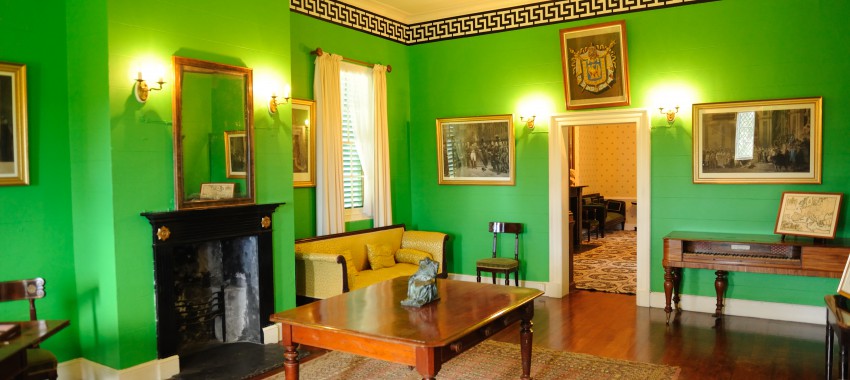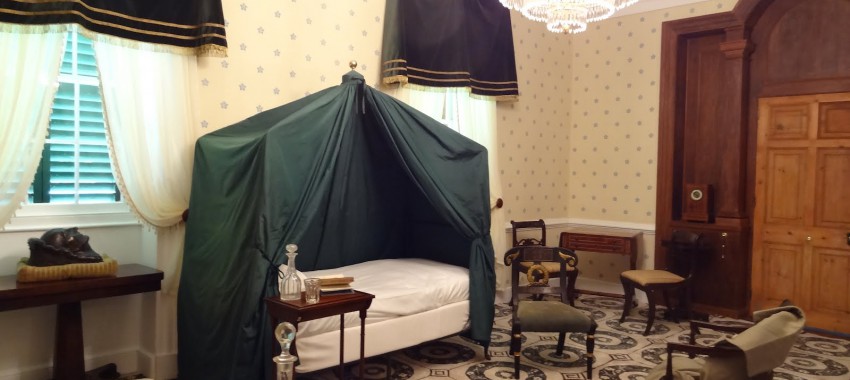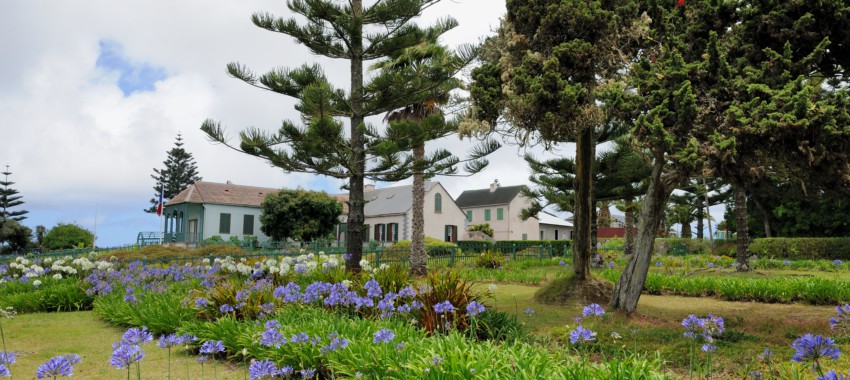The French Domains of St Helena – organisation and practical information
‘Saving Napoleon’s House on St Helena’
Between 2010 and 2014, the Fondation Napoleon, the Minister of Foreign Affairs and the Domaines Nationaux de Sainte-Hélène ran a large restoration project of Longwood House, at a cost of nearly 2.2 million euros.
Originally, the idea was to restore the generals’ wing of the House which had been poorly rebuilt in the 1930s. The wing was in such immediate danger that the French Minister of Foreign Affairs dedicated an initial fund of 700,000 euros. The Fondation Napoléon agreed to increase the sum by a further 700,000 euros. To gather this fund together, the Fondation worked alonside the Souvenir Napoléonien and the Fondation du Patrimoine (Heritage Foundation). Together, the partner organisations launched an international public fundraising campaign. The campaign, which closed on the 31st December 2014, raised 1.4 million euros from around 2,000 individual donors.
A detailed historical and architectural study was carried out, directed by Michel Jantzen, honorary chief architect of France’s Historical Monuments, after which work on the general’s wing could begin. This work was completed both in the time scale and within the budget which had initially been set out. The building was rebuilt and properly protected from adverse weather conditions, and the interiors were re-arranged. Since its reconstruction, Longwood has held the collections of the Domaines Nationaux de Sainte-Hélène (engravings, paintings, furniture and historical artefacts), meaning that the Gourgaud and Montholon apartments could be returned to their previous usage as the Domaines’ reception rooms.
The remaining funds were directed towards restoration work which was as vital and as urgent as the architectural work, namely: the restoration of the salon where, on the 5th May, 1821, the Emperor died; the restoration of the bathroom Napoleon used during his exile; the repair of the roofing of the kitchen areas; the transport of 32 historic pieces of furniture to France for restoration then transporting them back to Saint Helena. For the other authentic pieces of furniture (of which there are around eighty), a workshop has been set up in the old stables for restorers trained on site by a heritage restorer sent specially from France. For this training operation, the government of Saint Helena committed a subsidy of 100,000 euros.
The donors’ generosity also brought about other projects, such as new signage across the Domaines, consultancy concerning the reorganisation of the management of the Domaines in view of the opening of Saint Helena airport (June 2016), creation of new welcome documents, and presentation of all of the work undertaken in the form of a large exhibition ‘Napoléon à Sainte-Hélène’ at the Musée de l’Armée in Paris (March-July, 2016).
The Domaines Nationaux de Sainte-Hélène have been run by Michel Dancoisne-Martineau since 1987. The domaines are made up of three sites, whose historical significance and importance in the nation’s collective memory need no further elaboration:
- Longwood House, its outbuildings and gardens (the latter designed by Napoleon himself, and replanted and maintained for the last thirty years following this design) inside a surrounding wall, with a total area of 1 hectare.
- The Domaine de la Tombe, Napoleon’s burial place between 1821 and 1840, situated at the bottom of a valley, with a total area of 14 hectares.
- The Pavillon des Briars, the first place where Napoleon lived in exile (October-December 1815), comprising the original house that was extended after the Emperor’s departure from the rooms which were then called the ‘apartments of three English admirals’, because it was in this place that the commanders of the surveillance flotilla were housed until 1821. The total area is 1 hectare.
Longwood House and the Domaine de la Tombe were bought by France in 1858. The Pavillon des Briars was given to France by the descendants of the original owner, the famous William Balcombe, in 1959. The last property was acquired by a donation of land by Michel Dancoisne-Martineau (who had in turn acquired it in order to protect the site from uncontrolled urbanisation) in 2004.
The total area of the Domaines Nationaux of Saint Helena is 16 hectares.
Project Summary and Appeal Results.
List of donors so far (in French).
Full Report on the result of the St Helena appeal.
NEW MANAGEMENT FOR THE FRENCH DOMAINS OF ST HELENA

On 14 October 2015 in the Generals’ Wing at Longwood House, two important contracts were signed, thereby completing the work achieved by the appeal “Saving Napoleon’s House on St Helena”.
The first of these – jointly signed by the French Ministry of Foreign Affairs and of Ministry of International Development (MAEDI), the Government of St. Helena and the Fondation Napoléon – established a non-profit company, the Saint Helena Napoleonic Heritage Ltd.
The purpose of the second contract by the MAEDI was to delegate the daily management of the property and activities of the French Domains of St Helena [that is, Longwood House, The Briars and the Domain of the Tomb] to the newly created company Saint Helena Napoleonic Heritage Ltd. This is what is known as a “delegation of services”.
For the purpose of signing these important contracts “on site”, Laurent Fabius, the French Minister of Foreign Affairs, had delegated his ambassador Jean Mendelson, Goodwill Ambassador, former ambassador to Cuba and former Director of the French Diplomatic Archives. The other signatories of the first agreement were Mark Capes, governor of St Helena, and Victor-André Masséna, Prince d’Essling, president of the Fondation Napoléon. For the second contract, Susan O’Bey represented the Saint Helena Napoleonic Heritage.
Creating a management company: the Saint Helena Napoleonic Heritage Ltd
A non-profit private company under St Helenian jurisdiction, Saint Helena Napoleonic Heritage Ltd was born on 14 October. It is headed by a board of directors composed of one representative of each of the signatories: the France State (represented by Michel Dancoisne-Martineau, Director of the French Domains of St Helena and employed by the MAEDI); the Government of St Helena (represented by Thomas Holvey, Chief Economist); the Fondation Napoléon (represented by Thierry Lentz, Director). The company’s accounts will be certified and published each year.
This company is responsible for the ongoing management of the three places constituting the French Domains of St Helena: Longwood, the Valley of the Tomb and the Briars.
Responsibility for the management of both the property and the use of the French Domains has been delegated to Saint Helena Napoleonic Heritage Ltd.
Via the contract that it has signed with the French Republic, Saint Helena Napoleonic Heritage Ltd is now responsible for the ongoing operation of the Domains, with the aim, firstly, of gradually reducing the costs to the French state, for example by the gradual transfer of local staff to within the company and, secondly, to maintain a high-quality level of maintenance and also to offer services. French government funding will be gradually reduced until the company’s own resources are able to cover its ongoing costs and any small investments that may be required. The contract signed between the French State and the company includes the list of tasks for which the company will take immediate responsibility.
The annual aims of the company will be decided by the Director of the French Domains of St Helena. Immediately following the signing of the contract, the company is to put in place a structure enabling the collection of entrance fees, the offering of the various spaces for private rental and the sale of souvenirs at the Domain gift shop. The residue of the fundraising appeal “Saving Napoleon’s House in St Helena” will be made available to the company for initial expenses. Note that the aim of the company is not to generate profit and that all financial gains will be used for the maintenance of the buildings and the grounds, the development of the collection and other small investments.
The French State remains the owner of the property of the French Domains of St Helena as well as of the artworks of Longwood Museum.
The signing of these contracts does not affect the ownership of the French Domains which remains that of the French State. The Domains Director continues to be the guarantor of the proper use, the conservation and the proper functioning of everything within the area.
The same goes for the ownership and the conservation of objects and artworks submitted by various institutions which form the Museum of Longwood. Nothing has changed with regard to these issues, and these artworks are in no way affected by the agreements signed on 14 October.
Greater flexibility whilst remaining within conservation guidelines
Thanks to the contracts signed on 14 October, the French Domains now enjoy a greater flexibility of management. In particular, they will be able to run on their own resources. The partners have also promised their continued support. This means for example, that the Government of St Helena will continue to maintain security in the area, the Fondation Napoléon will remain the historical partner of choice for the Domains; and the French State and its representative on site will remain competent in matters of conservation.
This modernisation of the management of the Domains will allow them to function better and to be freer in their movements.
ST HELENA – A PRACTICAL GUIDE
Here we give some practical information about the trip to St Helena as well as the email addresses of contact persons for the various questions that travellers may have.
Please note that the Helenian interlocutors are English-speaking and that the prices indicated are subject to variation, given the high inflation rate on the island.
THE VOYAGE > How to get to St Helena
- By air
Air travel is the main means of transportation to St Helena.
Weekly flights to the island depart from Johannesburg and Cape Town in South Africa.
The only place where you can buy your plane tickets directly (at the moment, we strongly advise you to choose the departure from Johannesburg and not Cape Town) is on the website: flyairlink.com
- By sea
However, it is also possible to travel to St Helena by boat.
A few shipping companies offer cruises with stopovers usually not exceeding one day on the island.
For sailors: moorings are available in Jamestown harbour; red buoys are for boats of 20 tons or more. The “port control” which operates 24 hours a day gives the mooring coordinates and indicates which type of buoy to take. Obligation to call the “ferry service” to go ashore.
- Advice to travellers
The British government provides advice to travellers before planning the trip: consult the site. https://www.gov.uk/foreign-travel-advice/st-helena-ascension-and-tristan-da-cunha
ON THE ISLAND
- Accommodation on the island
All the possibilities are listed on the tourist office website.
- Conditions for visiting Napoleonic sites
Longwood House and the Tomb
The ticket price for Longwood House and the Tomb is £10 during opening hours which are:
For Longwood House, every day from Monday to Friday included from 11am to 1pm,
for the Domaine of the Tomb Napoléon, every day from Monday to Friday included from 9am to 3pm.
The Briars
The ticket price for the Briars Pavilion property is £5, open only on Wednesdays and Fridays from 10am to 11am.
- Visits outside business hours
It is possible to visit outside the official opening hours but only by prior arrangement by contacting BEPSP@helanta.co.sh. The basic price for a private visit is £150. If the number of visitors exceeds six, an additional £10 per person will be charged.
- Longwood House Space Rentals
Gardens: the use of the green spaces is only possible by preliminary arrangement with the company BEPSP, delegate of visits and rentals: BEPSP@helanta.co.sh
- The Generals’ apartments: Spend a night at Longwood House
For something out of the ordinary, you can experience spending one or more nights at Longwood House in the rooms once occupied by the Count de Las Cases and his son where the beds of General Gourgaud and the Count of Montholon were placed.
This exclusive service is available via Sainte-Héléne-Voyage – contact: PASCAL LAPARLIERE > pascal.laparliere@voyage.sh
- Receptions: Only by preliminary arrangement with BEPSP@helanta.co.sh
- A guided tour of the French Domains in the company of the Director Michel Dancoisne-Martineau
Guided tour of the island (i.e. Jamestown, island tour etc.) and/or Napoleonic places by the director is possible at the cost of £300 for the first hour and £100 per extra hour. These sums are donated to Saint Helena Napoleonic Heritage Ltd, a local non-profit foundation in charge of the estates.
- Photography and video requirements
Taking photos or video is possible only by prior arrangement by contacting BEPSP@helanta.co.sh
For TV and press reporting (whose promotional interest must be demonstrated): access to Longwood House is free from Monday to Friday from 9am to 10.30am and from 1.30pm to 3.30pm. Due to the small size of the property the team should not exceed 3 people with a single tripod. This team must be supervised by a member of the management and whose attendance hours will be charged at £25 per hour or part thereof. For Napoleon’s tomb (only the view from the observation platform is allowed): free every day from Monday to Friday from 9am to 3pm. For the Briars Pavilion, which is rented out all-year-round, only the outdoor areas can be visited on Wednesdays and Fridays from 10am to 11am.
For photographic and/or audio-visual reports: only possible outside public opening hours, namely Monday to Friday from 9am 10:30 and from 1.30pm to 3.30pm. The price for this privilege is £300 (including the guardian’s fee). All requests within and/or beyond the above hours, £50 per hour or part thereof shall be charged. For filming or photography on Saturdays, Sundays or Bank Holidays, the fee is £300 plus £50 per hour.
[Information correct as of February 2018]






